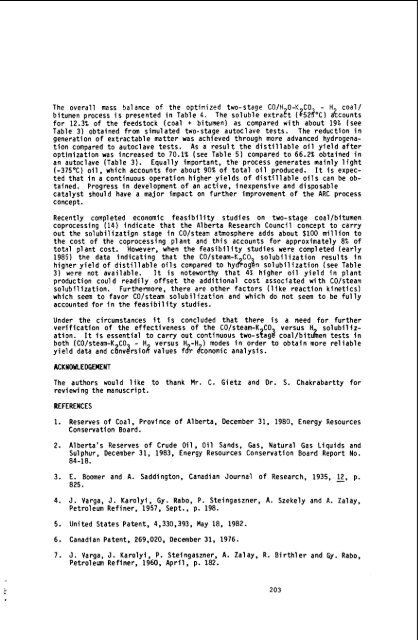Liquefaction co-processing of coal shale oil at - Argonne National ...
Liquefaction co-processing of coal shale oil at - Argonne National ...
Liquefaction co-processing of coal shale oil at - Argonne National ...
Create successful ePaper yourself
Turn your PDF publications into a flip-book with our unique Google optimized e-Paper software.
The overall mass balance <strong>of</strong> the optimized two-stage CO/H 0-K CO - H <strong>co</strong>al/<br />
bitumen process is presented in Table 4. The soluble extrast (3523°C) &<strong>co</strong>unts<br />
for 12.3% <strong>of</strong> the feedstock (<strong>co</strong>al + bitumen) as <strong>co</strong>mpared with about 19% (see<br />
Table 3) obtained from simul<strong>at</strong>ed two-stage autoclave tests. The reduction in<br />
gener<strong>at</strong>ion <strong>of</strong> extractable m<strong>at</strong>ter was achieved through more advanced hydrogen<strong>at</strong>ion<br />
<strong>co</strong>mpared to autoclave tests. As a result the distillable <strong>oil</strong> yield after<br />
optimiz<strong>at</strong>ion was increased to 70.1% (see Table 5) <strong>co</strong>mpared to 66.2% obtained in<br />
an autoclave (Table 3). Equally important, the process gener<strong>at</strong>es mainly light<br />
(-375OC) <strong>oil</strong>. which ac<strong>co</strong>unts for about 90% <strong>of</strong> total <strong>oil</strong> produced. It is expected<br />
th<strong>at</strong> in a <strong>co</strong>ntinuous oper<strong>at</strong>ion higher yields <strong>of</strong> distillable <strong>oil</strong>s can be ob-<br />
tained.<br />
c<strong>at</strong>alyst should have a major impact on further improvement <strong>of</strong> the ARC process<br />
<strong>co</strong>ncept.<br />
Recently <strong>co</strong>mpleted e<strong>co</strong>nomic feasibility studies on two-stage <strong>co</strong>al/bitumen<br />
<strong>co</strong><strong>processing</strong> (14) indic<strong>at</strong>e th<strong>at</strong> the Alberta Research Council <strong>co</strong>ncept to carry<br />
out the solubiliz<strong>at</strong>ign stage in CO/steam <strong>at</strong>mosphere adds about $100 million to<br />
the <strong>co</strong>st <strong>of</strong> the <strong>co</strong><strong>processing</strong> plant and this ac<strong>co</strong>unts for approxim<strong>at</strong>ely 8% <strong>of</strong><br />
total plant <strong>co</strong>st. However, when the feasibility studies were <strong>co</strong>mpleted (early<br />
1985) the d<strong>at</strong>a indic<strong>at</strong>ing th<strong>at</strong> the CO/steam-K CO solubiliz<strong>at</strong>ion results in<br />
higher yield <strong>of</strong> distillable <strong>oil</strong>s <strong>co</strong>mpared to hy&og%n solubiliz<strong>at</strong>ion (see Table<br />
3) were not available. It is noteworthy th<strong>at</strong> 4% higher <strong>oil</strong> yield in plant<br />
production <strong>co</strong>uld readily <strong>of</strong>fset the additional <strong>co</strong>st associ<strong>at</strong>ed with CO/steam<br />
solubiliz<strong>at</strong>ion. Furthermore, there are other factors (like reaction kinetics)<br />
which seem to favor CO/steam solubiliz<strong>at</strong>ion and which do not seem to be fully<br />
ac<strong>co</strong>unted for in the feasibility studies.<br />
Under the circumstances it is <strong>co</strong>ncluded th<strong>at</strong> there is a need for further<br />
verific<strong>at</strong>ion <strong>of</strong> the effectiveness <strong>of</strong> the CO/steam-K CO versus H solubiliz-<br />
<strong>at</strong>ion. It is essential to carry out <strong>co</strong>ntinuous two-s?ag$ <strong>co</strong>al/bit&en tests in<br />
both (CO/steam-K CO - H versus H -H modes in order to obtain more reliable<br />
yield d<strong>at</strong>a and cbnv&sior? values f& Aonomic analysis.<br />
ACKNOULEDGEUENT<br />
The authors would like to thank Mr. C. Gietz and Dr. S. Chakrabartty for<br />
reviewing the manuscript.<br />
REFERENCES<br />
Progress in development <strong>of</strong> an active, inexpensive and disposable<br />
1. Reserves <strong>of</strong> Coal, Province <strong>of</strong> Alberta, December 31, 1980, Energy Resources<br />
Conserv<strong>at</strong>ion Board.<br />
2. Alberta's Reserves <strong>of</strong> Crude Oil, O i l Sands, Gas, N<strong>at</strong>ural Gas Liquids and<br />
Sulphur, December 31, 1983. Energy Resources Conserv<strong>at</strong>ion Board Report No.<br />
84-18.<br />
3. E. Boomer and A. Saddington, Canadian Journal <strong>of</strong> Research, 1935, 2, p.<br />
825.<br />
4. J. Varga, J. Karolyi, Gy. Rabo, P. Steingaszner, A. Szekely and A. Zalay,<br />
Petroleum Refiner, 1957, Sept., p. 198.<br />
5. United St<strong>at</strong>es P<strong>at</strong>ent. 4,330,393, May 18. 1982.<br />
6. Canadian P<strong>at</strong>ent, 269,020, December 31. 1976.<br />
7. J. Varga, J. Karolyi, P. Steingasmer. A. Zalay, R. Birthler and Gy. Rabo,<br />
Petroleum Refiner, 1960, April, p. 182.<br />
203

















